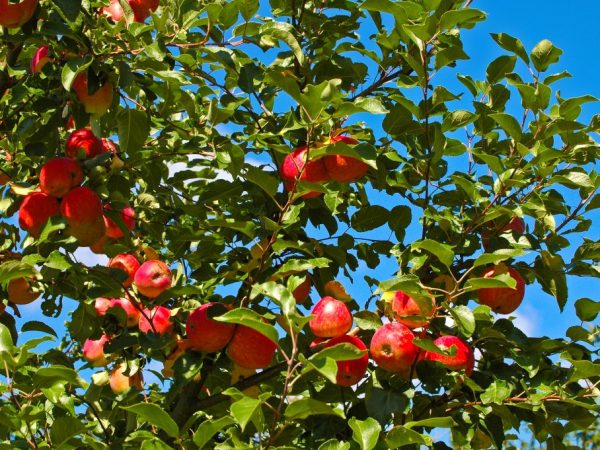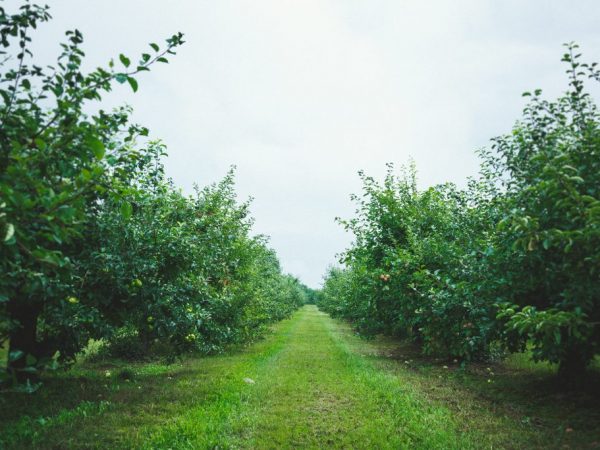Varietal characteristics of the Orlik apple tree
Apple Orlik is a variety that was bred more than 50 years ago. It attracts gardeners and summer residents with its early maturity, as well as juicy and fragrant fruits.
- Characteristics of the variety
- Advantages and disadvantages
- Description of the tree and fruit
- Taste
- Yield
- Pollinators
- Subspecies and variants
- Landing
- Selection of seedlings
- Planting timing and technology
- Care
- Watering
- Top dressing
- Pruning and shaping the crown
- Features of ripening and fruiting
- Harvesting and storage
- Features of growing in the regions
- Gardeners reviews

Varietal characteristics of the Orlik apple tree
Characteristics of the variety
The variety was sectioned at the Oryol zonal fruit and berry experimental station in 1959 by crossing the Mekintosh (Macintosh) and Bessemyanka Michurinskaya apple trees. Its authors, E. N. Sedov and T. A. Trofimova, achieved that in 1970 the variety was accepted for state trials. Since 1976, the species has received wide zoning.
Advantages and disadvantages
The advantages of the apple tree include:
- high early maturity, already at 3-4 years of tree life;
- high fruiting rate;
- resistance to low temperatures;
- medium resistance to scab;
- nutritious, healthy and tasty fruits.
Disadvantages:
- possible shedding of fruits in case of untimely start of harvesting;
- periodicity in fruiting.
Description of the tree and fruit
Orlik is a winter variety. Trees are medium-sized. The crown is neat, compact, and has a rounded shape.
The description suggests that Orlik apples are placed on simple and complex ringlets.
Large oval leaves and bright green color. They are heavily pubescent, because of this, they have a grayish tint.
The tree blooms profusely: bright pink buds, opening, turn into pale pink flowers of large size with closed petals.
Fruits are medium in size, most within 100 g, but there have been cases when the weight of one apple reached 200 g. Round and slightly flattened fruits have a shiny rind with a slight characteristic waxy bloom.
Fruits that have reached maturity have a greenish-yellow tint. After lying down, the apples acquire a light yellow color. A bright purple blush covers the entire surface of the apple. Sometimes the fruit turns completely red. The apples are covered with many visible gray subcutaneous dots.
Taste
The color of the juicy pulp is delicate creamy with a greenish tint.
The taste of Orlik apples is defined as sweet and sour, although the sourness in ripe fruits is practically not noticeable. Experts evaluate the variety on this basis on a 5-point scale at 4.4-4.6 points.
Orlik belongs to the dessert varieties.
Yield

Productivity depends on the age of the tree
Productivity is uneven, increasing according to the degree of growth of the tree. The tree begins to bear fruit 5 years after planting. For example, a 7-year-old apple tree can bring about 35 kg of fruit, and trees up to 20 years old - up to 120 kg.
Pollinators
This species is not self-fertile and needs pollinators nearby. For cross-pollination, the following varieties are chosen: Bogatyr, Renet Chernenko, Zhigulevskoe, Moscow winter, Pepin saffron, Northern Sinap, etc.
Subspecies and variants
There are two subspecies: on dwarf and semi-dwarf rootstocks. Both options are suitable for small areas as in no way inferior in characteristics to the variety, they just take up less space.
Landing
Since the tree belongs to medium-sized and has a compact round crown, it will be an excellent option for growing not only in large gardens, but also in ordinary summer cottages.
Selection of seedlings
Seedlings should be bought from trusted gardeners or in special stores, only in this way you can be sure that you have purchased a cutting of the desired variety. Better to buy annual trees, they have the best adaptive properties.
Before buying, inspect the stalk for damage, the buds should not yet bloom. The roots should be beautiful, healthy, without rot, thickening and other damage.
Pay attention, if the roots are dry, put aside the cutting, it is no longer suitable for planting, its chances of good survival are small.
Wrap the roots of the purchased plant with a damp cloth.
Planting timing and technology
The best time for planting is September - October.
Planting technology of the Orlik apple variety is as follows:
- we select a place for planting, it is unacceptable to sow a tree in lowlands and near water bodies;
- digging holes with the calculation of 2 m of area per tree;
- we prepare the soil: we mix sand, peat, clay, compost and humus, as well as mineral fertilizers that are necessary in a certain region;
- we place the seedling in the ground and straighten its roots;
- the root collar should be above the ground;
- having tamped the ground near the tree, we form a near-trunk circle;
- we make watering with the calculation of 6 buckets of water per 1 tree.
Care
In order for a fruit tree to bring a high-quality and rich harvest, it is necessary to provide it with decent care.
Watering

Trees need regular watering
Watering must be done regularly and in moderation, you must not allow the soil to dry out too much. In hot summers, the tree needs to be watered abundantly.
The first time you need to water the tree is in the spring, before buds form on it. The next time is after flowering. The third time to irrigate the apple tree is 2 weeks before harvest.
Top dressing
The tree requires mandatory feeding in the spring. A mixture of 0.5 kg of urea and 40 g of nitrate is suitable for this. Wood ash is a universal top dressing; it is applied every year when digging with the calculation of 200 g per 1 sq. m. In the autumn, after harvesting, the trees are fed with mullein, mineral fertilizers.
Please note: for young trees, the dose of fertilizer should be chosen as the minimum; full top dressing is permissible for the 4th year of life.
Pruning and shaping the crown
Annual pruning is primarily for sanitary purposes. Dry branches removed in time when thinning the crown provide a better harvest and help a good wintering of the tree. More than 25% of the branches cannot be cut in one year.
Features of ripening and fruiting
The Orlik apple tree begins to bear fruit in the 4th year of life. Already at the age of 4-7 years, she produces 45 kg of fruits from one tree annually.
The flowering period occurs in late spring - early summer. Large flowers gradually change their color from red to pale pink. In the first year, the color must be cut off so that the tree does not waste energy on the ovary, but forms the trunk and crown.
Harvesting and storage
You can start harvesting at the end of September. The fruits retain their original properties until the beginning of spring.
Fallen fruits are best sent for processing immediately, they quickly lose their properties. The optimum storage temperature is 0-5 ℃.
Features of growing in the regions
Considering all the features of the variety, Orlik is excellent for the Central Region, the Central Black Earth Region and the North-Western District. Having created the right conditions for the tree, it is successfully cultivated in the Moscow region and in the Urals.
The variety is not suitable for the Siberian region, because although it is resistant to extremes and low temperatures, it is not able to withstand them for too long.
Gardeners reviews
Every gardener who bought an Orlik apple tree for his plot was satisfied and now advises it to others. After all, one tree is enough to provide a family with tasty and healthy fruits until spring, as well as create many homemade preparations. Not distinguished by whims in care, this variety continues to collect fans.

